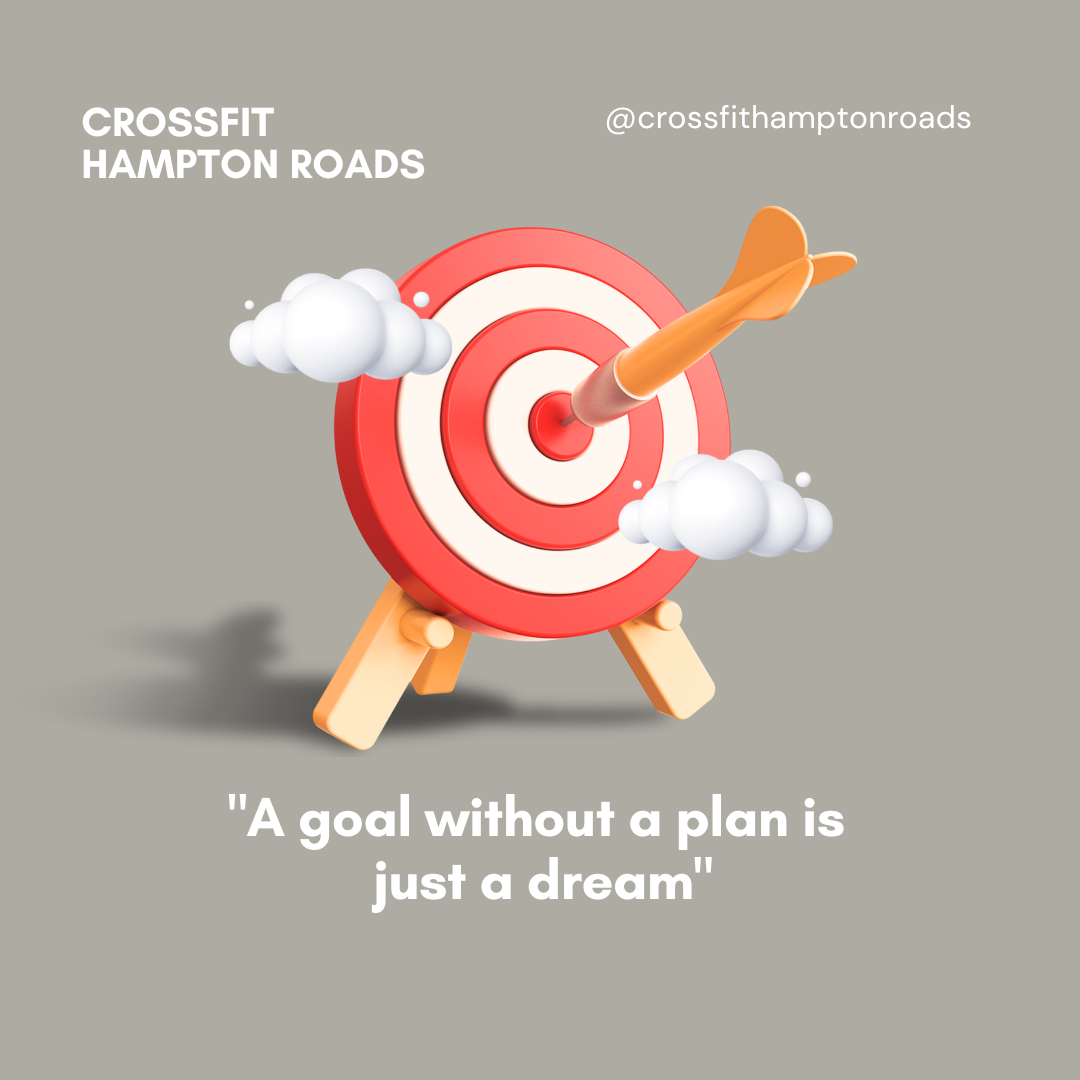Leveling Up your goal-setting game with emotional connection
CROSSFIT HAMPTON ROADS – COACH GABRIEL “gaberock” AVILLA
Introduction
If you’ve ever done any goal-setting, you’ve probably heard of SMART goals – an acronym to help you remember the well-developed guide to help you to plan and achieve your goals. SMART stands for Specific, Measurable, Attainable, Relevant, Timebound. SMART goals create a framework for breaking down a task into more manageable and measurable pieces, but unfortunately they’re not great for those bigger, strategic goals that you truly want to accomplish.
Where do we go from here?
So if SMART goals aren’t the answer to accomplishing your life goals, what is? Introducing WHOOPIE. WHOOPIE is a creative combination of the original acronym WOOP by psychologist and academic Gabriele Oettingen, with additional modifications by Ben Bergeron, Head Coach and owner of several CrossFit affiliates and founder of CompTrain.
Breaking down WHOOPIE
WHOOPIE is an acronym that outlines the framework for your goal-setting game with emotional connection. By tapping into this strong connection, you will create a mindset that will help push you to achieve the goals you truly want to achieve. Here is a summary of WHOOPIE, followed by a further breakdown of each component:
- Wish/Hope: find a goal that is challenging but realistic.
- Outcome: visualize achieving this dream by imagining the outcome with your five senses. This attaches emotion that gives you greater motivation.
- Obstacle: What internal and external obstacles might you encounter? Write them out in “What-If” statements.
- Plan: What can you do to overcome your obstacles? Plan out your “if-then” solution to each “What-If” situation.
- Identity: Tie your identity to the goal using “I am the type of person that…” statements.
- Execute: A goal without action is just a dream. Time to get off your butt and put your money where your mouth is.
Wishing and Hoping
What is a wish/hope you want to achieve? You want to choose a wish/hope that’s challenging, but is possible to achieve in a given time. Maybe it’s back squatting your body weight, running a mile without stopping, or having Rx next to your name on the whiteboard. Think big, knowing that the road to that goal won’t be easy, but will be worth it. In this breakdown, we will use the goal of achieving 10 strict pull-ups.
Outcome
Part One
The SMART framework still has tons of benefits, so we will actually use it to start the
- Specific: I want to perform 10 strict pull-ups.
- Measurable: I will perform 10 strict pull-ups prior to on September 15th, 2023.
- Attainable: I will attend CrossFit Hampton Roads classes at least three times a week and perform accessory work on my own time.
- Relevant: I want to become a stronger athlete. I want to be able to pull my body weight up without assistance and perform a WOD at the Rx level.
- Timebound: I will start training April 15th, 2023 and continue training appropriately so I can perform a WOD as designed by my coach that includes pull-ups.
Part Two
What is it going to feel like when you accomplish that goal? Think of that wish/hope – really think of it. Immerse yourself in the grand vision of it. Use your five senses and really sink into it.
I’m going to imagine myself prepping for the WOD. I can feel the chalk on my hands and my muscles loose and ready to perform. I can hear the music pumping. I can smell the air swirling in the gym as a I take a deep breath when I hear “10 SECONDS.” I not only feel excited, but I feel confident and excited to see my name on the whiteboard with the “Rx” badge next to it.
I know that when I finish the WOD, the fist bumps and high fives will be that much sweeter. My coach will know that I have put the work in and have earned this achievement. My fellow athletes have seen me put in work consistently and have seen my progress over the last few months. I feel proud of myself and the dedication I have committed to not only achieving my goal…but smashing it.
Why is visualization so important? This in-depth imagination gets you excited. It’s tying emotion to the event, so it becomes real. You want that emotion to help to drive you to reach that goal. The human brain is wired to give you feel-good hormones when you dream like this. If you can’t feel the goal on an emotional level like this, then you need to pick a different dream – something that really matters to you.
Obstacle
Now that you have your wish/hope in mind and you can envision yourself achieving it, what’s holding you back? What’s keeping you from achieving your goal? Think of both internal and external obstacles and write them out as “what-if” situations.
For internal factors – What thoughts and behaviours might play a role? This is something inside of you that prevents you from reaching your goal. For example, what if I start to compare myself to other athletes in the gym and feel discouraged because I’m not progressing as quickly as I hoped?
For external factors – What obstacles might arise that would hinder your motivation to reach your goal? For example, what if I wake up in the dark, hear the pouring rain and feel the need to snooze my alarm so I can stay in my nice, warm bed?
Plan
Once you’ve written all the “what-If” situations, you’ll have to think about what you can do to overcome these obstacles. Time to make the “if-then” plans using this formula: “If (obstacle happens) then I will (plan/solution).” Using my two examples above:
- If I start to feel discouraged because I’m not progressing as quickly as I thought, I will review my training logs to date and remind myself of how far I’ve come from when I began. My only benchmark is the one I created.
- If it’s pouring rain and windy and I feel the desire to skip my run to stay in bed, I will have all my workout gear prepared the night before, and I will remind myself to look forward to a cup of hot coffee when I get back from class as a reward.
Identity
Motivation can be fleeting, which is why you need to spend time defining your identity that you can always rely on. It’s easy to do something different and difficult for a few days, but what about weeks? Months? Years? As famous coach Jocko Willink says, “Discipline equals freedom.” This is why you need to tie your goal to your identity. It’s the reminder of the person you want to become through the actions you take. You create statements using “I am the type of person that…” so that you can become that person in the future, now.
When you do your wishing and hoping, you subconsciously create the type of person you strive to become. So if you talk about yourself in the present tense as if you were already that type of person, you’ll be able to push through with your plan when those obstacles arise. You are the type of person that overcomes those obstacles that stop other people from reaching their goals.
Following the “cozy bed” example: I am the type of person that prepares for my workout the night before, gets up no matter what, and arrives at the gym to put work in.”
Another, more broad example: “ am the type of person who sticks to their goals and perseveres, even when things become difficult or discouraging because I know the reward of the long term outweighs the discomfort of the short term.” Or “I am the type of person that follows the plan because I’m disciplined.
Small yet consistent steps that slowly built positive habits will set you on the path towards achieving that big goal of yours. After all, you’re the sum of your habits. “Atomic Habits” author James Clear speaks on how your identity ties into making long-lasting habits making “every action you take a vote for the type of person you wish to become.”
Execute
“Don’t talk about it, be about it.” If you perform all of the components of WHOOPIE yet fail to bring them to action, your wishes/hopes will never be achieved. They will only live as a shadow in your mind, constant haunting you. There is a simple solution to this: take bold action. Those actions can be a mix of small and big, but it is up to you to take them.
Conclusion
Emotionally connecting with your goals through WHOOPIE can unlock a path to success you haven’t previously achieved. This plan isn’t complicated, so don’t over think it. Goal-setting using WHOOPIE can be smartly used to organize the chaos in your mind and transform those thoughts in purposeful action towards your wish/hope. Remember, even the smallest of baby steps are still steps in the right direction. We all stumble sometimes, so remember to be kind to yourself along the way.
Your goals are right in front of you…how much do you want them?
Resources
- “Why Using SMART Goals are Outdated and What You Should Use Instead, “ Portia Zoffroni, 4 January, 2022. https://portiazaffaroni.com/blog/why-using-smart-goals-are-outdated-and-what-you-should-use-instead
- WOOP My lIfe, Gabriele Oettingen. https://woopmylife.org/en/home.
- WHOOPIE, Chasing Excellence Podcast, Ben Bergeron. https://www.youtube.com/watch?v=xzVE9P5vv48.





